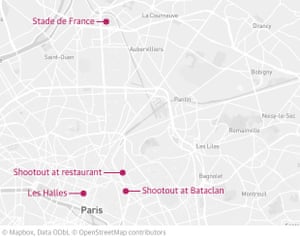My old high school was best known in our district for two things: its sport teams and its International Baccalaureate program. As my klutzy nature kept me from excelling at any sport other than badminton (Asian heritage for the win!), it was the
IB Diploma Program that convinced me to enroll at Montgomery High School. I wanted to take the most advanced courses possible and build up my college application marketability, so it sounded like IB was the way to go.
Founded nearly 50 years ago, the
IB organization is a nonprofit institution that offers an international education to students at over 3,500 IB World schools in 145 countries; it also offers a
Middle Years Program for students from 11 to 16 years old, and even a
Primary Years Program for students from 3 to 12 years old, building up to the
Diploma Program for students from 16 to 19 years old.
The Diploma Program includes an advanced academic curriculum and several core requirements, including the Extended Essay (a kind of senior thesis), Theory of Knowledge (an epistemology course that emphasizes the IB philosophy), and CAS (extracurricular activities highlighting “creativity, action, and service” that counterbalance academic studies). Your IB final examination scores and fulfillment of above requirements determine whether or not you earn the IB diploma. I’ve found that American students rarely take on the IB diploma to attend university outside of the States, but rather to earn as many college-transferable credits as possible (to “get ahead” in completing General Education requirements in college,) or increase their college application marketability by boasting the IB diploma as an achievement on their resume.

When I hit junior year, I took as many IB classes as I could, but when I looked more closely at the diploma requirements, final examinations, and the likelihood of transferring credits to my future college (undetermined at the time), I started second guessing my goal to earn the diploma. The IB program is great, and the classes definitely prepare you for the rigor of college courses, but there really is no guarantee for transferring credits from IB classes if you don’t know which college you want to attend (which is largely the case for high school sophomores about to commit to the IB Diploma Program).
In a best case scenario, my friend
*Dan did the IB diploma and entered
Brigham Young University as a junior because all his IB classes were transferable. In a worst case scenario, I had a friend named
*Blake who completed the IB diploma and didn’t get into ANY of the schools to which he applied, but this was mainly because he didn’t take academics seriously for the first two years of high school; he went on to study at the local junior college for two years and transferred to the
University of Southern California no sweat. (
Don’t let this last story freak you out; it just goes to show that the IB diploma doesn’t guarantee anything, even though some people make it out to be an automatic admission ticket to a good college).
The IB diploma and the stories of the students working to earn it raises the frustrating question, “What does it take to get into a good college today?” and the underlying question, “Is the IB diploma really worth it?” I realized this may be a relevant topic for our readers at The Prospect, so I interviewed a handful of friends and friends of friends about their experiences with the IB diploma. What I found out surprised me.
Christina’s Story: Dealing with IB Stereotypes
One of our own interns at The Prospect *Christina is currently an IB diploma candidate, somewhat anxious for this article to state her name, as she herself has been wondering whether or not she truly wants to commit to the IB diploma. Her high school offers a range of course levels – International Baccalaureate, Advanced Placement, Honors, Regents, College Level (SUPA, Adelphi, etc.) courses, and Applied – but is gradually getting rid of AP courses and switching to IB. The IB program was introduced to her high school three years ago by a new principal (who is now, unfortunately, leaving), and the first class of IB students just graduated in 2012. Approximately 65 students in Christina’s grade tried out the IB program as juniors, but the number dropped down to 30 by the end of the year.

What IB students spend most of their time doing.
Christina initially committed to the IB diploma for a handful of reasons. “It was supposedly the most rigorous course load; my guidance counselor encouraged me to do it; I was intrigued by the CAS hours (I thought they would be a way of finding more opportunities to participate in the community); and the majority of my classes were IB… so I thought, ‘Why not?’ when going for the diploma,” she says.
Although Christina expressed how much she enjoyed her IB teachers and the classes themselves, she did mention a commonly held perception of the program’s atmosphere created by IB students. “In my school, the personality of the IB students comes out in ToK class because that’s the only class with solely IB students in it. This is only my opinion (I’m biased in that I don’t like the IB program and I don’t like the kids in it), but I get the feel that IB is viewed and treated as a sort of program for ‘gifted’ students when in actuality, anybody can enter the program,” she admits. “The students are sort of pompous, condescending, and over confident. I’m over exaggerating a bit, but a lot of the students believe that they’re better [or] more intelligent than other kids.”
Christina’s main criticism of her school’s IB program concerned the scheduling of IB classes in conflict with AP classes: committing to the IB program would mean missing out on AP classes she really wanted to take. Many high schools that include both IB and AP courses place a heavy emphasis on one of the programs, more often on the IB program, as many IB courses include material that sufficiently prepares students to take the AP exam in that subject but AP courses fail to fulfill requirements specific to the IB diploma. Christina believes she’ll continue with the IB diploma, since she’s already completed a year of the program, but her story does bring up some important points.
Courtland’s Story: The IB Conveyor Belt
Courtland Thomas, an IB diploma graduate from Florida, is gearing up for his second year at
Columbia University, as part of
Columbia College (which has the infamous
Core Curriculum, similar to that of IB). Courtland was able to share how the IB program prepared him for academics at Columbia and the college experience itself. His high school offers alternative options to IB, such as AP, honors, and dual enrollment (a popular option); approximately 70 students in his class of 500 earned the IB diploma.

“The IB program at my school was very much like a factory. It didn’t offer a large variety of courses in any of the 6 subjects, so you walked in, got put on a conveyer belt, and went through the whole thing. Of course, some people chose to jump off, or were put on the belt by their parents, but that’s generally what it felt like.” Since his high school had limited resources to support an IB program, Courtland confessed that, “my school wasn’t what I was fully expecting of the IB program – at least not the full flexibility to explore what subjects I wanted to…I would have loved to study have studied anthropology at the Higher Level, or French SL (both of which I’m now studying in college), but my school didn’t have the scheduling capabilities to allow such flexibility in my course selection.” Courtland was impressed by the passion that his teachers expressed for their IB course subjects, which Courtland had difficulty finding outside the IB program, even in the summer classes he took at the community college.
Courtland quite accurately described the program as “engulfing,” in substitution for the typical adjective “stressful” that most IB students use. “You walk into the IB program as one of the few in your school, and everyone knew whether you were an ‘IB kid’ or not. You were around all other students taking the IB a majority of the time, and, eventually, you gain this sort of community. You all undergo the same stress, the same judgement from your non-IB cohorts, and the same expectations of your professors to do your best, so you feel a group of students who legitimately have the same ideas or desires as you – knowledge.” An exclusive sort of society, but a strengthening one.
Looking back, Courtland admits that earning the IB diploma was the right choice for him. “I completed 3 years of Spanish and I was able to have a casual conversation about the protests in Egypt for my oral; I learned more about biology than I would have if I hadn’t done the IB simply because it didn’t fascinate me enough to take an additional courses in it; I probably would never had learned my passion for photography because I wouldn’t have taken a single visual arts course. But I do think the amount of time and effort I put into it would have been better utilized or appreciated if I had attended a different IB school.” Courtland’s story makes the point that not every IB World school necessarily has a strong IB program; this is something any IB diploma candidate should consider before fully committing to the program.

In terms of transfer credits, none of Courtland’s IB courses transferred for college credit at Columbia. In the case of my transfer credits,
Wesleyan University only accepts a maximum transfer of two pre-matriculation credits. Wesleyan, like many other liberal arts colleges, really wants you to explore the classes
it offers, which is what you’re paying for anyways; I figure that the whole transferring credits thing is really only appropriate if you have a good idea of what you want to study and want to get ahead in that field, or if you’re financially strained and
want to save money by graduating early. I realized that, in my case at least, completing the diploma would be a big waste of time. Instead, I took a few IB classes (in English and Spanish), a few AP classes (in math and science), and several junior college classes (in subjects, like American history, that I absolutely did not want to slave over at an IB level). Junior college classes are almost always guaranteed to transfer to whatever college/university you end up attending as a full-time student, and they’re generally
easier than IB classes.
To IB or Not to IB, That Is the Question
From what I’ve found, the IB diploma is right for you if you want to study overseas or if you know you want to attend a school that accepts enough IB credits to make your time and effort worthwhile. You don’t have to earn the IB diploma to go to a great school. But hey, if you do go for the diploma, don’t be embarrassed or feel like you’re a “sell out”. The diploma is ridiculously difficult to earn while both applying to college and keeping your social life afloat, and if you think you can do it (and, more importantly, that you should do it), then by all means, go for it!
I’m not sure if this isn’t a biased opinion, as I haven’t earned the IB diploma myself, but taking Junior College and AP courses alongside IB courses has worked for me and many other students I know. The most important thing is to challenge yourself academically, whether by completing the diploma or taking a smattering of higher level classes, without working yourself to death. You’re still in high school, and this is your time to have fun, too.


